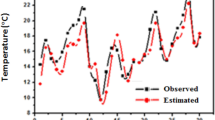Summary
Montly mean values of the global radiation intensity (Q s) and the screen temperature (T) for a year have been gathered from 67 places at latitudes below 60 degrees. Plotting temperature versus radiation in each case yiclds a loop, whose range, mid-point, area and general slope have been evaluated. Various regularities have been discovered in the interrelationships of these features, and between them and the altitude, the upwind distance overland (d), and the latitude (A). Annual means of the radiation (Qs cal/cms · min) and the temperature corrected for altitude (T c°C) are connected thus: Tc/Qs=102−1.2A. The quotient of the annual ranges of monthly mena temperatures and global radiation intensities (R T/RQ) varies asd 0.2
The empirical relationships allow approximate estimation of the annual loop of radiation and temperature of any place at a latitude less than 60 degrees. For this, it is necessary to know only the latitude, altitude and the overland distance upwind, so this method of obtaining indicative values of the monthly mean global radiation intensity and screen temperature may be useful for poorlyinstrumented regions.
Zusammenfassung
Es wurden Monatsmittelwerte der Intensität der GlobalstrahlungQ s und der LufttemperaturT über ein Jahr von 67 Stationen, deren Breite weniger als 60° betrug, gesammelt. Wenn man ein Diagramm mit der Temperatur und der Strahlung als Koordinaten zeichnet, erhält man mit den zusammengehörigen Werten einer Station eine geschlossene Kurve, deren Durchmesser, Mittelpunkt, Fläche und Achsenneigung für jede Station berechnet wurde. Es wurden verschiedene Beziehungen zwischen diesen Kurveneigenschaften untereinander und mit der Höhe, der Entfernungd, die die Luft bis zur Station über land zurückzulegen hat, und mit der geographischen BreiteA gefunden. Für die Jahresmittelwerte der Strahlung Qs (cal/cm2·min) und der mit einer Höhenkorrektur verscehenen TemperaturT c (°C) gilt die Beziehung: Tc/Qs=102−1,2A. Der Quotient zwischen den Jahresschwankungen der Monatsmitteltemperatur und der Intensität der GlobalstrahlungR T/RQ ist proportionald 0,2.
Diese empirischen Beziehungen gestatten eine näherungsweise Schätzung der Jahreskurve von Strahlung und Temperatur für jeden Ort mit einer Breite von weniger als 60°. Dazu ist nur die Kenntnis der geographischen Breite, der Höhe und der Entfernung von der Küste in der Richtung, aus der die Luftströmung kommt, nötig. Daher kann diese Methode zur Bestimmung von Näherungswerten der mittleren monatlichen Globalstrahlungsintensität und der Lufttemperatur in Gebieten mit geringer Beobachtungsdichte nützlich sein.
Similar content being viewed by others
References
Ashbel, D.: New World Maps of Global Solar Radiation during IGY. Hebrew Univ. Dept. Climatology and Meteorology, 16 pp., map. 13, Jerusalem, 1961.
Aslyng, H. C.: Evaporation and Radiation Heat Balance at the Soil Surface. Arch. Met. Geophys. Bioklim., B,10, 359–375 (1960).
Aslyng, H. C., andSv. E. Jensen: Radiation and Energy Balances at Copenhagen, 1955–64. Roy. Vet. Agric. Coll. Copenhagen Yearbook 1966, p. 22–40.
Chapas, L. C., andA. R. Rees: Evaporation and Evapotranspiration in Southern Nigeria. Quart. J. Roy. Met. Soc.90, 313–319 (1964).
Conrad, V.: Methods in Climatology, p. 171, 196. Cambridge, Mass.: Harvard Univ. Press, 1946.
Griffiths, J. F.: Solar Radiation, Its Measurement and Temporal Distribution. Inter-African Conference on Hydrology, Nairobi: Publ. Comm. Tech. Coop. Africa South Sahara, no. 66, p. 197–201 (1961).
Haurwitz, B., andJ. M. Austin: Climatology, p. 27. New York: McGraw-Hill, 1944.
Hewson, E. W., andR. W. Longley: Meteorology: Theoretical and Applied. New York: Wiley, 1944.
Linacre, E. T.: Resistances Impeding the Diffusion of Water Vapour from Leaves and Crops. Ph. D. thesis, London University, 1966.
Linacre, E. T.: Climate and the Evaporation from Crops. J. Irrig. Drain. Div. Am. Soc. Civ. Engr.93, 61–79 (1967).
Linacre, E. T.: Estimating the Net-Radiation Flux. Agric. Meteor.5, 49–63 (1968).
Linacre, E. T.: Net Radiation to Various Surfaces. J. Appl. Ecol. (in press).
McIlroy, I. C., andD. E. Angus: Grass, Water and Soil Evaporation at Aspendale. Agric. Meteor.1, 201–204 (1964).
McWhirter, N. C., andA. R. McWhirter: Guiness Book of Records (10th edn.), Guiness Superlatives, London, 1962.
Prescott, J. A., andJ. A. Collins: The lag of Temperature behind Solar Radiation. Quart. J. Roy. Met. Soc.77, 121–126 (1951).
Robelin, M.: Actual Evaporation of Various Well-Watered Cover Crops. Ann. Agron.13, 493–522 (1962).
Rijks, D. A., andW. G. Owen: Hydrometeorological Records from Areas of Potential Agricultural Development in Uganda. Pub. Uganda Government, Ministry of Mineral and Water Resources, 1965.
Rosenberg, N. J.: Solar Energy and Sunshine in Nebraska. Univ. Neb. Coll. Agric. Home Econ. Ag. Expt. Stn. Res. Bull.213 (1964).
Trewartha, G. T.: An Introduction to Weather and Climate, p. 52, 79–80. New York: McGraw-Hill, 1943.
Turc, L.: Evaluation of the Water Needs for Irrigation and Potential Evapotranspiration. Ann. Agron.12, 13–49 (1961).
De Vries, D. A.: Two Years of Solar Radiation Measurements at Deniliquin. Aust. Met. Mag.22, 36–69 (1958).
Author information
Authors and Affiliations
Additional information
With 13 Figures
Rights and permissions
About this article
Cite this article
Linacre, E.T. Empirical relationships involving the global radiation intensity and ambient temperature at various latitudes and altitudes. Arch. Met. Geoph. Biokl. B. 17, 1–20 (1969). https://doi.org/10.1007/BF02248857
Received:
Issue Date:
DOI: https://doi.org/10.1007/BF02248857




